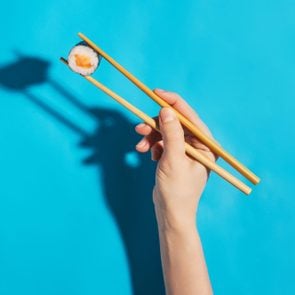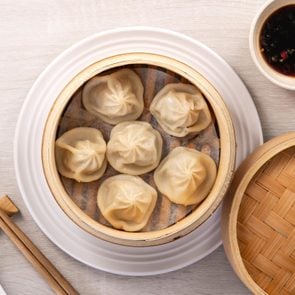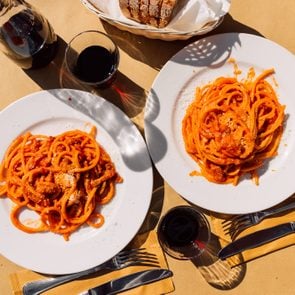50 Table Manners Everyone Should Know Before They’re 30
Updated: Feb. 22, 2024
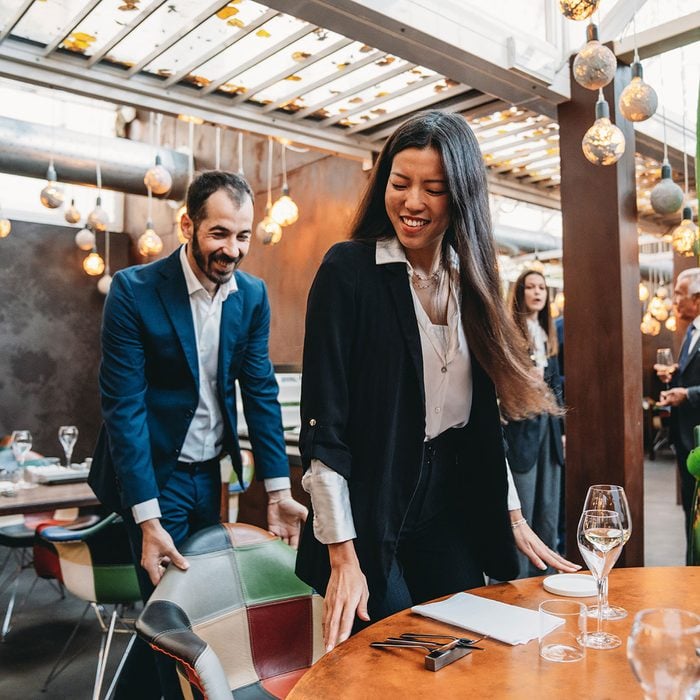
Those endless “elbows off the table” admonishments may have seemed like a drag in childhood, but they were actually setting the stage for good etiquette rules and good manners as an adult—and that’s about a lot more than simply knowing which fork to pick up or how to set the dinner table. “Table manners are a sign that you take the time to invest in yourself, not in a pretentious way but by being thoughtfully self-aware about how you make others feel,” says etiquette expert Diane Gottsman, founder of the Protocol School of Texas. “Good dining skills provide an opportunity to make others feel comfortable without them even noticing.”
While you may think that what happens in private doesn’t matter as much as in public, your habits set an example for others to follow, particularly if you have children, who soak up and emulate what they see every day. Add dinner-party etiquette and restaurant manners( like sending food back without being rude) to the mix, and the stakes may be even higher. “There’s a reason that second interviews are routinely conducted over a meal,” says Gottsman. “The recruiter wants to observe the applicant’s social skills and determine if they have the ability to behave appropriately in front of their best clients. The way we behave at the table is similar to how we behave in life. Taking the time to fine-tune those skills is a sign of someone who wants to excel in other areas as well.”
Follow the tips below, and you may find yourself at the top of the hiring (and parenting!) list, not to mention being that person others love to be around.
Get Reader’s Digest’s Read Up newsletter for more etiquette, humor, cleaning, travel, tech and fun facts all week long.
Proper Etiquette Tips: Before Eating
Table manners start long before you ever get to the table. “Planning takes effort,” says Gottsman, “and arriving on time means you won’t make other guests or the host wait for you.” To guarantee you’re on schedule for a dinner party or restaurant reservation, be sure to take into account everything from weather, directions and traffic (or potential train delays) to construction detours and the level of your gas tank.
Put away your cell phone
Once GPS has safely (and promptly!) delivered you to your destination, it’s time to put your cell phone away. “When you are constantly checking your phone at the table, it sends the message that what you are doing is more important than the person sitting across from you,” says Gottsman, who acknowledges that life sometimes necessitates staying in touch. For example, maybe you’ve left your child with a babysitter, or you’re a physician who’s on call. In those instances, she advises keeping your phone accessible, on vibrate and out of sight.
Don’t move the name cards
It takes time (and, sometimes, a few headaches) to carefully orchestrate a seating plan, so keep that in mind the next time you’re tempted to shift things around when you get to the table. “Don’t switch place cards so you are seated next to your BFF or your date,” says Gottsman. “The host has planned the personalities they want seated next to each other, and a good guest will oblige accordingly.”
Wait to eat
Whether you’re eating in a restaurant or a private home, proper table etiquette dictates that you let the host “lead the show.” Which means leaving the entire place setting intact until your host arrives at the table. (No nibbling on the bread or even taking sips of water!) Instead, wait for them to propose the welcome toast and/or be seated and start eating/drinking/lifting the napkin themselves.
Who is the host in a restaurant setting? If you’re with a group of peers, it’s not whomever did the suggesting and/or inviting; in that case, you’d likely be splitting the bill. Generally speaking, the wording on an invite, even an informal one, will be a good indicator if someone will be “hosting” a get-together like this. It might say something like, “I’d like to invite you to join us at …” or “I’d like you to be our guest at … ”
Napkin etiquette
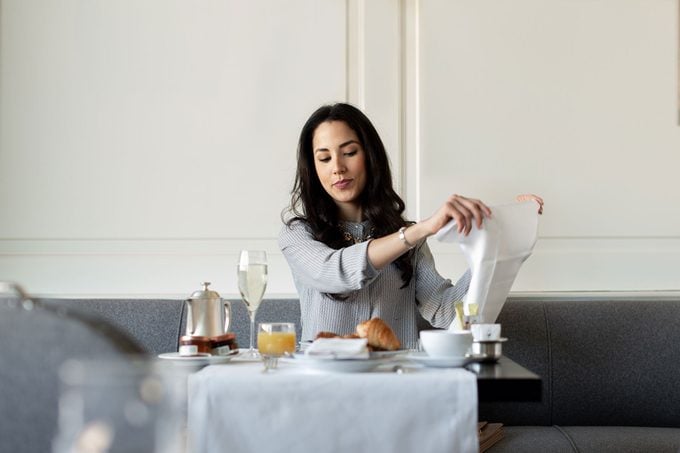
And speaking of napkins, handling one signals that it’s time to get down to the business of eating, so follow your host for cues that it’s go-time. “Napkins should stay on the table until the host begins the start of the meal by taking theirs from the table first,” advises Gottsman. If you really want to play the game right, a luncheon napkin is opened and placed across your lap, while a dinner napkin is folded in half and then placed.
You might not think anyone will notice that under-the-table detail, but people will notice (and likely frown upon) tucking said napkin into your shirt when messy food—like lobster or a plate of ribs—arrives at the table. Unless a special bib is offered and the setting is casual (i.e., backyard BBQ or fish shack), leave your napkin in your lap, eat carefully and hope for the best.
Need to get up to use the restroom? Deposit your napkin on the seat of your chair, not on the table. The latter is only OK at the end of the meal ands signifies that you’re done eating.
Beverage etiquette
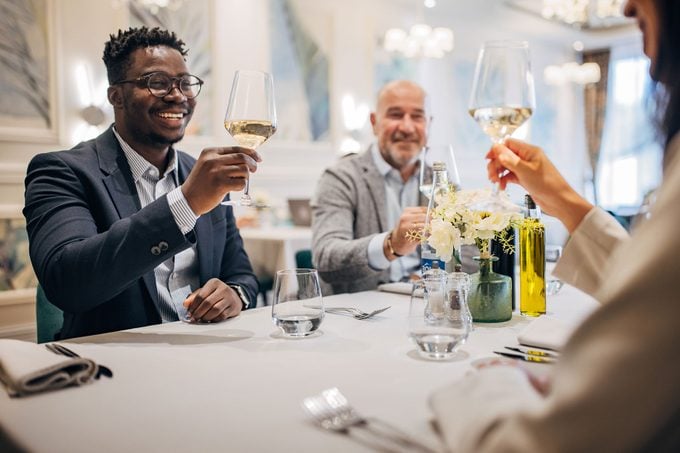
The wine’s being poured into fine glassware, and you’re first served. That doesn’t mean you should start drinking. It’s always polite to wait until all the glasses have been filled. (Discover these things that polite people always say.) And if there’s a host, even consider holding off until they raise their glass for a toast or take their own initial sip. (When it comes to champagne at a wedding, there’s additional wedding etiquette to follow, of course.)
When you do pick up the glass, Gottsman advises holding wine glasses by the stem, and glasses filled with water or soda securely by the bottom (not the rim). And if you’d like to skip alcohol completely, just place your hand over your glass when wine is offered. Never turn the glass upside down; it’s considered bad table manners. And no slurping.
When to start eating
That whole eat-while-it’s-hot thing is a serious no-no in all but the most casual, backyard BBQ–type settings. Whether you have a cold salad on your plate or a sizzling steak, it’s important to take the first bite only after everyone at the table has been served. And even then, if you’re at a dinner party, wait for your host to pick up their utensils before you dig in. (The one exception to this rule: at a buffet, where it’s OK to start eating once there are others seated at your table.) This is also something to keep in mind when you’re the one hosting a party so you don’t accidentally keep everyone waiting.
Formal Dining etiquette
It’s time to revisit those childhood elbows-off-the-table nudges (your parents were right!), along with a few extra reminders that will help you feel confident and comfortable in any public or formal dinner situation. “There is very little difference between formal and informal dining,” says Gottsman. “The rules are the same—what changes is the number of utensils, and that’s based on the courses served. Paper napkins and plastic utensils are all used and held exactly the same way.”
How to pass food
Food and condiments should be passed around the table counterclockwise. Not interested in those Brussels sprouts that just landed in your hands? Simply continue moving the dish around the table.
Conversely, if a neighbor wants a dish that’s out of reach and you’re in the passing zone, resist the urge to take some for yourself before handing it over. Instead, ask for it back after your neighbor has helped themselves.
As for salt and pepper, they’re considered a team and should always be passed as a set. Yes, even if only the salt has been requested.
How to rest your utensils
Not done eating but taking a break? Rest your silverware Continental style—it’s the most widely understood. Simply place your knife and fork in the center of your plate, slightly angled in an inverted V shape (the tip of the knife and fork tines point toward each other). This is also something to keep in mind when it comes to restaurant etiquette.
More food for thought
- Keep elbows off the table.
- Don’t chew with your mouth open.
- Cut one small bite of food at a time.
- Break off and butter a small piece of bread, rather than slathering the whole roll.
- Spoon soup away from your body. When you spoon away, the spill drops into the bowl and not on your shirt.
- Hold elbows close to your body when cutting food to avoid crowding neighbors.
- Do not hold bread, drink liquid and chew. Keep it to one action at a time.
- Be mindful of potentially “explosive” cherry tomatoes and other similar foods.
- Cough and sneeze into your left shoulder, covering your mouth with your left hand in a gentle fist. (Use your left hand to keep your right hand free for a goodbye shake.) Never use a napkin; otherwise, you’d be using the same napkin to wipe your mouth and hands.
Restaurant etiquette
Unlike dining in a private home, eating out can present unique table etiquette conundrums, especially because you’re at the mercy of waitstaff, menus and restaurant logistics. Learning the right restaurant bill etiquette will help you navigate the trickiest situations that are not always common sense.
- In a more formal setting, the person who invites pays. When in doubt, offer to foot the bill, and allow the other person to decline.
- Two friends going out to lunch should split the bill.
- To avoid awkward moments when you’re out to dinner with a group, ask for separate checks when you place your order.
- If you want to pick up the whole tab, discreetly let the server know in advance and give them your credit card.
- If you’re the first to arrive, wait for your host before being seated.d
- A host should allow a guest to order first, but give subtle hints if there are price-limit concerns. (For example, “That steak looks delish!”)
- Even better, avoid booking restaurants that are out of your financial comfort zone.
- Try to order the same number of courses as your companions.
- Tip well: 15% minimum, 20% average and 25%-plus for exemplary service.
- Be polite to the waitstaff no matter what their demeanor. It only shines well on you.
- When finished eating, place your silverware in the “done” position—knife and fork parallel to each other on the right side of the plate, facing diagonally upward and to the left.
Etiquette after eating
Table manners don’t stop just because the meal is over. These follow-up rules will be the icing on the proverbial cake.
- Place your silverware in the “done” position (see rule, above) and your napkin on the table—never on the dirty plate. Remember: Someone has to pick up that napkin!
- At a dinner party, don’t jump the gun and start clearing the table before the host has made the first move.
- Always offer to help, and allow your host to either accept or decline.
- You may refresh your lipstick at the table, but leave it at that. It isn’t appropriate to apply other makeup, floss or pick your teeth.
- Don’t overstay your welcome.
- Be sure to send a thank-you note or, at the very least, a thank-you email or text. (While it’s not mandatory to send an actual note card, handwritten still trumps technology.) If someone pays for the bill for an informal lunch or dinner, a verbal thank-you will suffice.
Manners FAQ
In addition to proper table manners, there are a few other things you might have questions about and should keep in mind.
Should I bring a hostess gift when I’ve been invited to a home?
Yes, but avoid fresh flowers that require immediate arranging and cutting. It’s a nuisance for a busy host. Chocolates, candles, wine or cute napkins are all preferable.
Is it OK to bring a gift of food for the meal?
Only when it’s given the green light by your host ahead of time. (And it’s best to ask what dish would be most helpful. Salad? Dessert? Appetizer?)
How do I let people know I want to make a toast?
Get the table’s attention by standing and raising a glass. No clinking with a fork.
How can I figure out the dress code?
If you’re being invited to someone’s home, ask the host. At a restaurant, go online and look at photos of the venue for clues. It’s always better to be slightly overdressed than underdressed, as it shows respect for your hosts and the event. Wondering about other types of events? Here’s what you need to know about wedding-guest attire and business-casual meetings.
When do I let people know about my dietary restriction?
The sooner, the better. Alerting your host to a food allergy or other issue (like, if you’re vegan) well before the event allows them time to make a menu change without frantic, last-minute prep. And call a restaurant ahead of time to make sure they can accommodate your request as well.
More From Etiquette:
- How Much to Tip Hairdresser
- Tips for Hotel Housekeeping
- How Much to Tip
- How Much to Tip for a Massage
- Small Talk Etiquette
- How to Host a Party
- Proper Etiquette
- Business Casual Etiquette
- Wedding Toast Examples
- What is an Irish Exit?
- What to Say in an Interview
- Email Etiquette
About the expert
- Diane Gottsman is an internationally renowned etiquette expert, author and speaker, as well as the owner of The Protocol School of Texas, a company specializing in professional etiquette training.

